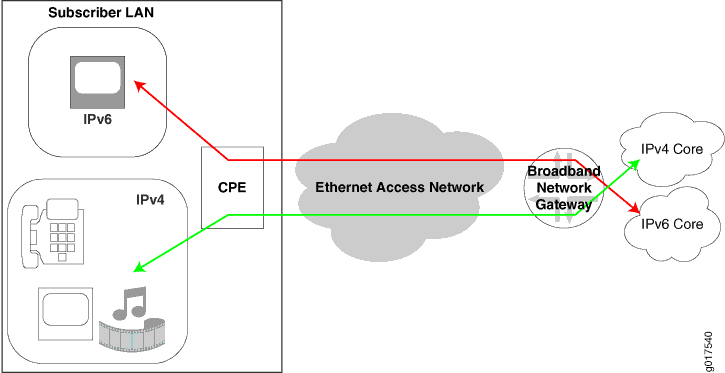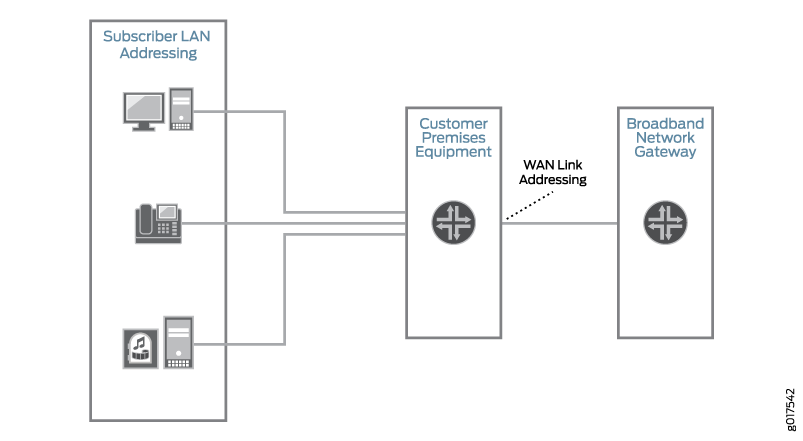Migration to IPv6 Using IPv4 and IPv6 Dual Stack
As a service provider, you can use the Junos OS IPv4/IPv6 dual-stack feature to begin your migration from IPv4 to IPv6 by implementing IPv6 alongside IPv4 in your existing subscriber networks. The feature allows you to implement IPv6 so that you can provide the same subscriber services over IPv6—video, voice, high-quality data—that you currently provide in your IPv4 networks. You can then perform incremental upgrades to IPv6 and avoid service disruptions while migrating from IPv4 to IPv6.
Basic Architecture of a Subscriber Access Dual-Stack Network
This Juniper Networks dual-stack architecture is designed for either DHCP-based or PPP/PPPoE-based subscriber access networks. In addition, this design allows you to layer DHCPv6 over PPPoE-based networks.
Figure 1 shows the components of a basic subscriber access network in which the subscriber LAN is running both IPv4 and IPv6 and is connected to the IPv4 and IPv6 core using a broadband network gateway (BNG) configured for dual stack. Using IPv4/IPv6 dual stack, the BNG can provide both IPv4 and IPv6 services over the access network to the subscriber LAN. A single interface can operate simultaneously in IPv4 and IPv6 modes.

Terms Used in IPv6 Subscriber Management Documentation
Table 1 defines terms used in the IPv6 subscriber management documentation.
Term |
Definition |
|---|---|
BNG |
Broadband network gateway. An IP edge router in which bandwidth and QoS policies may be applied. The BNG may encompass any or all of the functionality of B-RAS. |
CPE |
Customer premises equipment on the subscriber network that connects the subscriber network to the BNG. |
Delegated addressing |
Method of address assignment in which a host uses IPv6 prefixes to delegate IPv6 global addresses. In a dual-stack network, the CPE uses IPv6 prefixes that it receives to delegate global IPv6 addresses to individual subscriber equipment. |
Delegating router |
Role of the BNG when it delegates IPv6 prefixes to the requesting router (the CPE). |
DHCPv6 IA |
Identity association. A collection of addresses assigned to a client. Each IA contains one type of address. For example, IA_NA carries assigned addresses that are nontemporary addresses; IA_PD carries a prefix. |
DHCPv6 IA_PD |
IA for prefix delegation. An IA that carries a prefix that is assigned to the requesting router. Instead of assigning a single address, IA_PD assigns a prefix or a complete subnet. Referred to as DHCPv6 prefix delegation. |
DHCPv6 IA_NA |
IA for nontemporary addresses. An IA that carries assigned addresses that are not temporary addresses. DHCPv6 IA_NA is used to assign global IPv6 addresses. |
Global IPv6 address |
Unique IPv6 address that identifies a single interface and allows the interface to access the IPv6 internet. |
IPv6 address prefix/prefix length |
Combination of an IPv6 prefix (address) and a prefix length. The prefix takes the form ipv6-prefix/prefix-length and represents a block of address space (or a network). The /prefix-length indicates the number of contiguous, higher-order bits of the address that make up the network portion of the address. For example, 2001:DB8::/32 is an IPv6 prefix. |
IPCP |
IPv4 Control Protocol. A PPP protocol that establishes the IPv4 link between the BNG and the CPE if you are using PPPoE in your access network. |
IPv6CP |
IPv6 Control Protocol. A PPP protocol that establishes the IPv6 link between the BNG and the CPE if you are using PPPoE in your access network. |
Link-local address |
Locally derived address that is designed to be used for addressing on a single link for purposes such as automatic address configuration, Neighbor Discovery, or when no routers are present. It is indicated by the prefix FE80::/10. In your dual-stack network, you can use a link-local address on the interface that connects the CPE and the BNG. |
NDRA |
Neighbor Discovery Router Advertisement. An IPv6 protocol that is used in the dual-stack network to allow automatic addressing on the CPE WAN link. |
Neighbor discovery |
Protocol in the IPv6 protocol suite that allows nodes on the same link to advertise their existence to their neighbors, and to learn about the existence of their neighbors. |
Prefix list |
Table that contains IPv6 prefixes. |
Requesting router |
Role of the CPE when it requests IPv6 prefixes from the delegating router (the BNG). |
Router Advertisement (RA) |
Message that the BNG periodically sends to hosts or sends in response to Router Solicitation (RS) requests from another host. The message includes IPv6 prefixes and other autoconfiguration information. In a dual-stack network, the router sends RAs to CPE devices on its access network. |
Router Solicitation (RS) |
Message that hosts send to discover the presence of on-link routers. In a dual-stack network, CPE devices send RS messages to the BNG. |
Unnumbered address |
Address that can be used on the router’s PPPoE loopback interface that connects to the CPE. |
IPv6 Addressing Requirements for a Subscriber Access Network
You need to implement two types of addressing for IPv6 in a subscriber access network:
WAN link addressing—For the WAN interface on the CPE (CPE upstream interface).
Subscriber LAN addressing—For devices connected to the CPE on the subscriber LAN (CPE downstream interfaces).
Figure 2 shows where WAN link addressing and subscriber addressing are assigned in a dual-stack network.

You can use the following methods for assigning IPv6 addresses:
For WAN link addressing, you can use Neighbor Discovery Router Advertisement (NDRA) or DHCPv6 Identity association for nontemporary addresses (IA_NA) to provision a global IPv6 address.
For subscriber LAN addressing, you can use DHCPv6 prefix delegation to provision global IPv6 addresses to subscribers on the LAN.
Alternatives to Using a Global IPv6 Address on the CPE WAN Link
If the CPE is supplied by or recommended by the service provider, you do not need to provision a unique global IPv6 address on the CPE. In this case, the broadband network gateway (BNG) can use the loopback interface to manage the CPE. You can use one of the following methods to provision an address on the loopback interface:
Link-local IPv6 address—Can be used on PPPoE access networks. The link-local address is provisioned by appending the interface identifier negotiated by IPv6CP with the IPv6 link-local prefix (FE80::/10).
Address derived from DHCPv6 prefix delegation—Can be used on PPPoE access networks or on DHCP access networks. If you use DHCPv6 prefix delegation for subscriber addressing, the CPE can use the prefix it receives from the BNG to assign an IPv6 address on the loopback interface between the CPE and the BNG. This address can be used to manage the CPE, and the CPE uses it as a source address when it communicates with the BNG.
